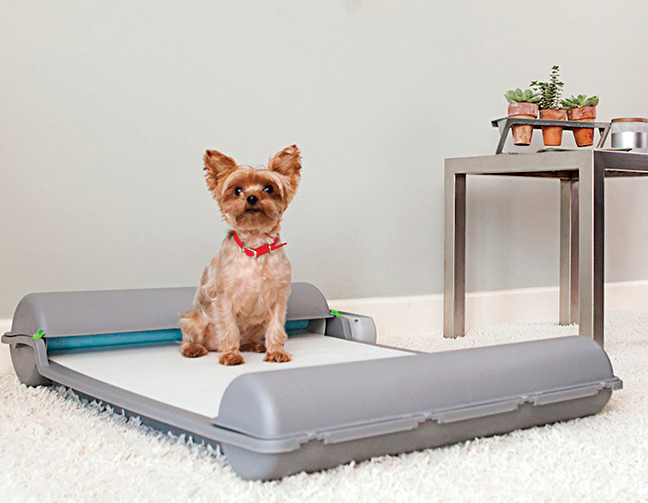
Creating clean-up contraptions for pets.
Alan Cook W’95 EAS’95 has drawn a surprising amount of entrepreneurial inspiration from an inconvenient truth: We love our pets, but we hate cleaning up their messes.
His first company, Lucky Litter, was inspired in 2002 by dealings with a then-girlfriend’s cat.
“I cleaned the litter box exactly one time, and I was like, ‘I love you, but I’m never doing this again,’” he recalls with a laugh. After an unsuccessful search for a self-cleaning alternative, he teamed up with Wharton professor (now vice dean of entrepreneurship and innovation) Karl Ulrich [“Method Inventor,” Sep|Oct 2016] to develop a self-cleaning litter box called ScoopFree. Lucky Litter also developed the FroliCat family of electronic cat toys.
Cook sold that company in 2012 and not long after got a phone call from a Penn mechanical engineering student who was working on a prototype for a self-cleaning puppy pad. He explained that he was looking for pointers from a professional.
“I just started to laugh,” recalls Cook, whose own undergraduate experiences included creating an automatic tennis racket stringing machine for his engineering senior design project. “When I looked at their design, it was something that my litter box engineers [had] brainstormed in Karl’s office, back in like 2002 or 2003.”
The engineering undergraduate introduced him to Brett Shorenstein V’15 (then finishing up his degree at Penn Vet), who had come up with the idea for the self-cleaning dog pad and commissioned the undergrad to build a prototype. Seeing ways to improve the machine, Cook and Shorenstein worked out a deal, got a patent, and created a new company: Brilliant Pet 2.
The BrilliantPad Self-Cleaning Dog Potty Pad can be used for older dogs as well as for training puppies. (Since it’s important for dogs to go outside, a dog pad should act as a supplement to outdoor activity, not a replacement.) The apparatus “refreshes” automatically to seal off waste and bad smells. It can go weeks at a time without needing to be changed, and replacing the pad roll is mess-free.
Cook notes that he and his team “had to use some crafty engineering techniques in order to get rid of the wasteful components of the pad.” By eliminating a middle “filler layer” meant to hold the pad’s shape, each sheet uses roughly one-third the material required for a regular dog pad. And the take-up reel that enables mess-free disposal is made of a biodegradable plastic additive called Ecopure.
Grateful to be working with his old Wharton and Penn Engineering professors, Cook is also excited to be collaborating with Penn Vet.
“There’s something about being in a university-based veterinary clinic,” he says. “It’s the breadth of experience and all the research into animal behavior. What makes our products so good is that they’re really good for the animal.”
—Sofia Demopolos C’17

